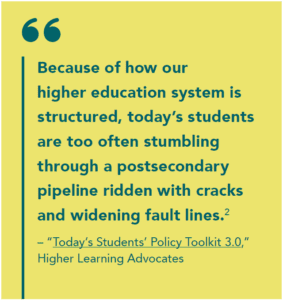Braided Funding Backgrounder
Today’s students follow myriad pathways to and through higher learning. Providing today’s students with wraparound supports and tools to navigate complex career pathways systems can greatly boost their chances of success, but requires multiple resources. For students, this means the programs they rely on for career and income mobility have limited sets of resources from year to year. A singular funding stream is often unreliable and insufficient for providing the full scope of program services or delivering a program at scale. Braided funding can bridge the gap and allow programs the resources needed to succeed.
WHAT IS BRAIDED FUNDING?
 Braided funding, sometimes referred to as blended funding or co-investing, combines different funding streams to support one program or activity at the institutional or state level. In the context of higher learning, braided funding is commonly used to scale successful programs, jumpstart a new initiative, or sustain long-term growth. Braided funds have been particularly useful for workforce development programs, combining public funds and the resources of nonprofit organizations and grants for those in need of workforce support. By exploring and implementing similar models of effective braided funding, programs providing career pathways for students can have sustainable and replicable funding.
Braided funding, sometimes referred to as blended funding or co-investing, combines different funding streams to support one program or activity at the institutional or state level. In the context of higher learning, braided funding is commonly used to scale successful programs, jumpstart a new initiative, or sustain long-term growth. Braided funds have been particularly useful for workforce development programs, combining public funds and the resources of nonprofit organizations and grants for those in need of workforce support. By exploring and implementing similar models of effective braided funding, programs providing career pathways for students can have sustainable and replicable funding.
ADVANTAGES
Integrated K-12 and postsecondary career pathways programs provide an “increased number of skilled workers with credentials of value to the labor market” through cost-efficient programming. The effectiveness of a career pathways approach is clear: it increases educational attainment, employment, and short-term earnings. But institutions and states can’t rely on one stream of funding to sustain these programs. Cuts in federal funding for workforce development programs make single funding streams unstable or inadequate. Braided funding can help create sustainable programs by diversifying funding sources so cuts or losses to any single source would not be as impactful on the overall financial health of the program. Leveraging existing funds and programs will also reduce anticipated costs while still providing necessary services to students.
Read How Braided Funding Can Support Today’s Students in Career Pathway Programs here.
